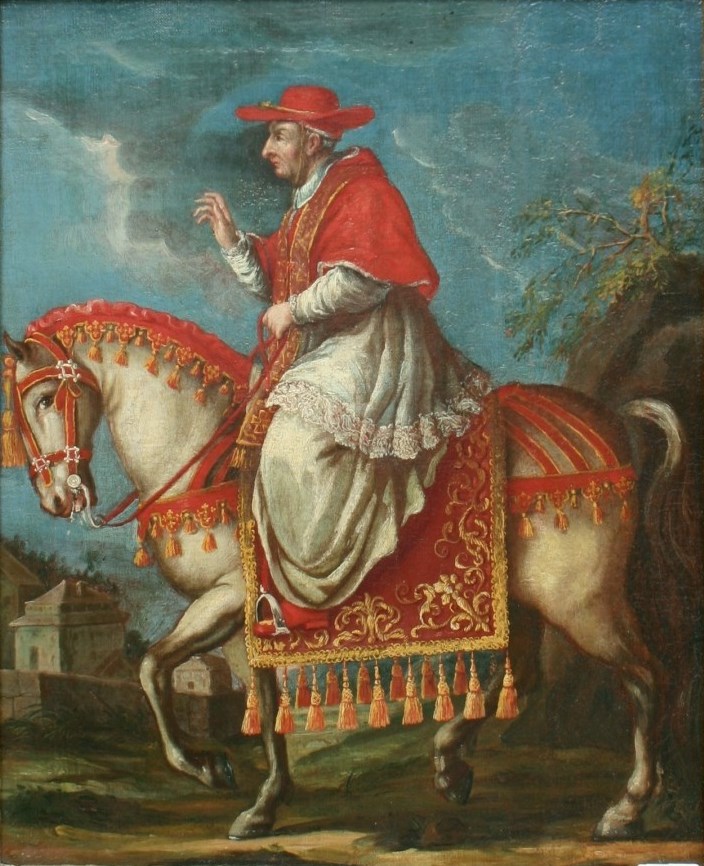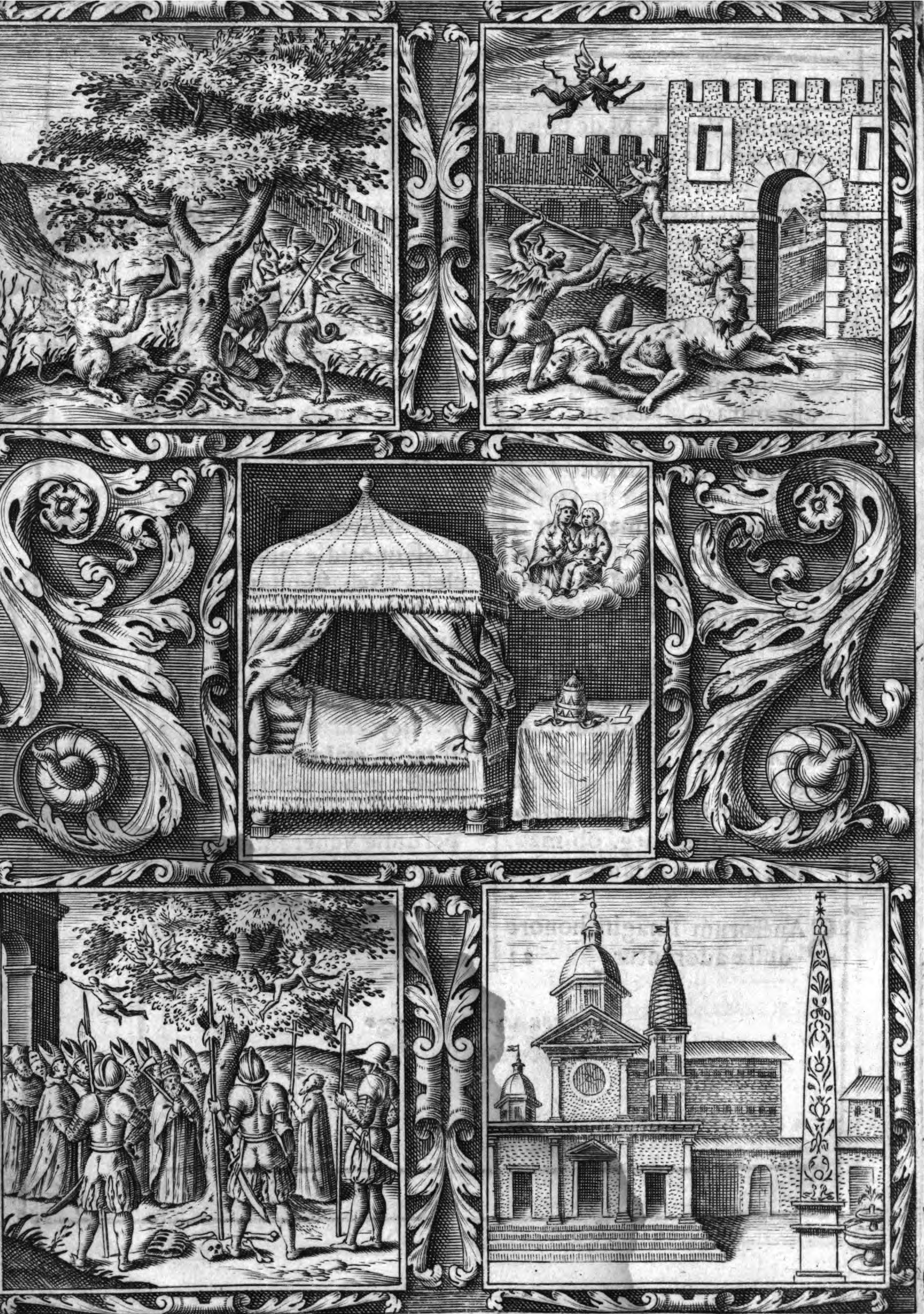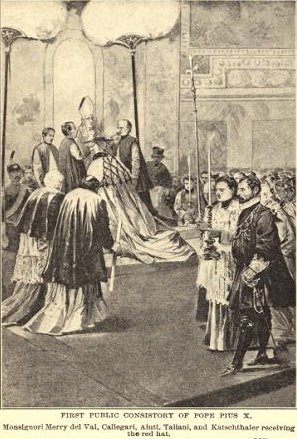|
Camillo Cibo
Camillo Cybo Malaspina (April 25, 1681 in Massa Carrara – January 12, 1743 in Rome) was an Italian cardinal of the Catholic Church. Early life Born into the aristocratic Cybo Malaspina family, he was the son of Carlo II Cybo, duke of Massa, who was a descendant of Pope Innocent VIII and Teresa Pamfili. Cybo was great grand nephew of Pope Innocent X, and nephew of Cardinal Benedetto Pamphili. Ecclesiastical career * 1705 — Ordained as Priest * 1718 — Appointed as Titular Patriarch of Constantinople. He was ordained Bishop that same year, and named Auditor general of the Apostolic Chamber. * 1729 — Elevated to Cardinal Santo Stefano al Monte Celio in the Consistory of March 23, under Benedict XIII. * 1731 — Appointed Cardinal-Priest of Santa Maria del Popolo * 1741 — Appointed Protector of Santa Maria degli Angeli Patronage of the arts As many important figures of the time, Cybo was a patron of the arts. One of his proteges was Pietro Locatelli Pietro Antonio L ... [...More Info...] [...Related Items...] OR: [Wikipedia] [Google] [Baidu] |
Camillo Cybo 1729
Camillo is an Italian masculine given name, descended from Latin Camillus. Its Slavic languages, Slavic cognate is Kamil. People *Camillo Agrippa, Italian Renaissance fencer, architect, engineer and mathematician *Camillo Almici (1714–1779), Italian priest, theologian and literary critic *Camillo Astalli (1616–1663), Italian cardinal *Camillo Benso, conte di Cavour (1810–1861), a leading figure in the movement toward Italian unification, founder of the original Italian Liberal Party and Prime Minister of the Kingdom of Piedmont-Sardinia *Camillo Berlinghieri (1590 or 1605–1635), Italian painter *Camillo Berneri (1897–1937), Italian professor of philosophy, anarchist militant, propagandist and theorist *Camillo Boccaccino (1546), Italian painter *Camillo Boito (1836–1914), Italian architect, engineer, art critic, art historian and novelist *Camillo Borghese (1550–1621), Pope Paul V, the Pope who persecuted Galileo Galilei *Camillo Borghese, 6th Prince of Sulmona (177 ... [...More Info...] [...Related Items...] OR: [Wikipedia] [Google] [Baidu] |
Pope Benedict XIII
Pope Benedict XIII (; ; 2 February 1649 – 21 February 1730), born Pietro Francesco (or Pierfrancesco) Orsini and later called Vincenzo Maria Orsini, was head of the Catholic Church and ruler of the Papal States from 29 May 1724 to his death in February 1730. A Dominican friar, Orsini focused on his religious responsibilities as bishop rather than on papal administration. Orsini's lack of political expertise led him to increasingly rely on an unscrupulous secretary (Cardinal Niccolò Coscia) whose financial abuses ruined the papal treasury, causing great damage to the Church in Rome. In the process towards sainthood, his cause for canonization opened in 1755, but it was closed shortly afterwards. It was reopened on 21 February 1931, but it was closed once again in 1940. It was opened once more on 17 January 2004, with the official process commencing in 2012 and concluding later in 2017. He now has the posthumous title of Servant of God. Early life He was born in Gravina in ... [...More Info...] [...Related Items...] OR: [Wikipedia] [Google] [Baidu] |
Latin Patriarchs Of Constantinople
The Latin Patriarchate of Constantinople was an office established as a result of the Fourth Crusade and its Sack of Constantinople (1204), conquest of Constantinople in 1204. It was a Roman Catholic replacement for the Eastern Orthodox Ecumenical Patriarchate of Constantinople and remained in the city until the reconquest of Constantinople by the Byzantines in 1261, whereupon it became a titular see. The office was abolished in 1964. History In the early middle ages, there were five patriarchs in the Christian world. In descending order of precedence: Rome by the Bishop of Rome (who rarely used the title "Patriarch") and those of Constantinople, Patriarch of Alexandria, Alexandria, Patriarch of Antioch, Antioch, and Latin Patriarch of Jerusalem, Jerusalem. The sees of Rome and Constantinople were often at odds with one another, just as the Greek and Latin Churches as a whole were often at odds both politically and in things ecclesiastical. There were complex cultural currents u ... [...More Info...] [...Related Items...] OR: [Wikipedia] [Google] [Baidu] |
Cardinals Created By Pope Benedict XIII
Cardinal or The Cardinal most commonly refers to * Cardinalidae, a family of North and South American birds **''Cardinalis'', genus of three species in the family Cardinalidae ***Northern cardinal, ''Cardinalis cardinalis'', the common cardinal of eastern North America ***Pyrrhuloxia or desert cardinal, ''Cardinalis sinuatus'', found in southwest North America ***Vermilion cardinal, ''Cardinalis phoeniceus'', found in Colombia and Venezuela * Cardinal (Catholic Church), a senior official of the Catholic Church **Member of the College of Cardinals * Cardinal Health, a health care services company * Cardinal number ** Large cardinal * Cardinal direction, one of the four primary directions: north, south, east, and west * Arizona Cardinals, an American professional football team * St. Louis Cardinals, an American professional baseball team Cardinal or The Cardinal may also refer to: Animals Birds In addition to the aforementioned cardinalids: * ''Paroaria'', a South American genu ... [...More Info...] [...Related Items...] OR: [Wikipedia] [Google] [Baidu] |
Bishops Appointed By Pope Clement XI
A bishop is an ordained member of the clergy who is entrusted with a position of Episcopal polity, authority and oversight in a religious institution. In Christianity, bishops are normally responsible for the governance and administration of dioceses. The role or office of the bishop is called episcopacy or the episcopate. Organisationally, several Christian denominations utilise ecclesiastical structures that call for the position of bishops, while other denominations have dispensed with this office, seeing it as a symbol of power. Bishops have also exercised political authority within their dioceses. Traditionally, bishops claim apostolic succession, a direct historical lineage dating back to the original Twelve Apostles or Saint Paul. The bishops are by doctrine understood as those who possess the full Priest#Christianity, priesthood given by Jesus in Christianity, Jesus Christ, and therefore may ordain other clergy, including other bishops. A person ordained as a deacon, pri ... [...More Info...] [...Related Items...] OR: [Wikipedia] [Google] [Baidu] |
18th-century Italian Cardinals
The 18th century lasted from 1 January 1701 (represented by the Roman numerals MDCCI) to 31 December 1800 (MDCCC). During the 18th century, elements of Enlightenment thinking culminated in the Atlantic Revolutions. Revolutions began to challenge the legitimacy of monarchical and aristocratic power structures. The Industrial Revolution began mid-century, leading to radical changes in human society and the environment. The European colonization of the Americas and other parts of the world intensified and associated mass migrations of people grew in size as part of the Age of Sail. During the century, slave trading expanded across the shores of the Atlantic Ocean, while declining in Russia and China. Western historians have occasionally defined the 18th century otherwise for the purposes of their work. For example, the "short" 18th century may be defined as 1715–1789, denoting the period of time between the death of Louis XIV of France and the start of the French Revolut ... [...More Info...] [...Related Items...] OR: [Wikipedia] [Google] [Baidu] |
1743 Deaths
Events January–March * January 1 – The Verendrye brothers, probably Louis-Joseph and François de La Vérendrye, become the first white people to see the Rocky Mountains from the eastern side (the Spanish conquistadors had seen the Rockies from the west side). * January 8 – King Augustus III of Poland, acting in his capacity as Elector of Saxony, signs an agreement with Austria, pledging help in war in return for part of Silesia to be conveyed to Saxony. * January 12 ** The Verendryes, and two members of the Mandan Indian tribe, reach the foot of the mountains, near the site of what is now Helena, Montana. ** An earthquake strikes the Philippines * January 16 – Cardinal André-Hercule de Fleury turns his effects over to King Louis XV of France, 13 days before his death on January 29. * January 23 – With mediation by France, Sweden and Russia begin peace negotiations at Åbo (Turku) to end the Russo-Swedish War. By August 17, Swed ... [...More Info...] [...Related Items...] OR: [Wikipedia] [Google] [Baidu] |
1681 Births
Events January–March * January 1 – Prince Muhammad Akbar, son of the Mughal Emperor Aurangzeb, initiates a civil war in India. With the support of troops from the Rajput states, Akbar declares himself the new Mughal Emperor and prepares to fight his father, but is ultimately defeated. * January 3 – The Treaty of Bakhchisarai is signed, between the Ottoman vassal Crimean Khanate and the Russian Empire. * January 18 – The "Exclusion Bill Parliament", summoned by King Charles II of England in October, is dissolved after three months, with directions that new elections be held, and that a new parliament be convened in March in Oxford. * February 2 – In India, the Mughal Empire city of Burhanpur (now in the Indian state of Madhya Pradesh) is sacked and looted by troops of the Maratha Empire on orders of the Maratha emperor, the Chhatrapati Sambhaji. General Hambirrao Mohite began the pillaging three days earlier. * March 4 – In order ... [...More Info...] [...Related Items...] OR: [Wikipedia] [Google] [Baidu] |
Pietro Locatelli
Pietro Antonio Locatelli (3 September 1695 in Bergamo – 30 March 1764 in Amsterdam) was an Italian Baroque composer and violinist. Biography Bergamo Little is known about Locatelli's childhood. In his early youth, he was the third violinist and held the title of ''virtuoso'' in the ''cappella musicale'' (musical establishment) of the church of Santa Maria Maggiore in Bergamo. His first violin teachers were probably Ludovico Ferronati and Carlo Antonio Marino, both of whom were members of the ''cappella''. The ''maestro di cappella'', Francesco Ballarotti, may have taught him composition. In autumn 1711 Locatelli went to Rome to seek greater recognition. Rome Locatelli began studying in Rome in autumn 1711, probably under Antonio Montanari or Giuseppe Valentini and perhaps for a short time under Arcangelo Corelli, who died in January 1713. In a letter of 17 March 1714 Locatelli wrote to his father in Bergamo that he was a confirmed member of the ''compita accademia di vari ... [...More Info...] [...Related Items...] OR: [Wikipedia] [Google] [Baidu] |
Santa Maria Degli Angeli E Dei Martiri
The Basilica of St. Mary of the Angels and of the Martyrs (, ) is a Catholic titular minor basilica and former Carthusian conventual church in Rome, Italy, constructed in the ruined '' frigidarium'' and '' tepidarium'' of the Roman Baths of Diocletian in the Piazza della Repubblica. It was constructed in the 16th century following an original design by Michelangelo Buonarroti. Other architects and artists added to the church over the following centuries. During the Kingdom of Italy, the church was used for religious state functions. Background The original building of the Santa Maria degli Angeli e dei Martiri was a bath house commissioned by Emperor Maximian in 297 AD and was completed in 306 AD. It is believed that Christian slaves constructed the baths using the finest materials from all over the Roman empire. Monoliths of granite from Egypt, wood from the Bavarian forests held up the vaulted ceilings and arches, and intricate mosaics decorated the walls. The baths ... [...More Info...] [...Related Items...] OR: [Wikipedia] [Google] [Baidu] |
Santa Maria Del Popolo
The Parish Basilica of Santa Maria del Popolo () is a titular church and a minor basilica in Rome run by the Augustinian order. It stands on the north side of Piazza del Popolo, one of the most famous squares in the city. The church is hemmed in between the Pincian Hill and Porta del Popolo, one of the gates in the Aurelian Wall as well as the starting point of Via Flaminia, the most important route from the north. Its location made the basilica the first church for the majority of travellers entering the city. The church contains works by several famous artists, such as Raphael, Gian Lorenzo Bernini, Caravaggio, Alessandro Algardi, Pinturicchio, Andrea Bregno, Guillaume de Marcillat and Donato Bramante. History Legendary founding The well-known foundation legend of Santa Maria del Popolo revolves around the evil memory of Emperor Nero and the cleansing of the area from this malicious legacy by Pope Paschal II. As the story goes, after his suicide Nero was buried in the mau ... [...More Info...] [...Related Items...] OR: [Wikipedia] [Google] [Baidu] |
Papal Consistory
In the Catholic Church, a consistory is a formal meeting of the College of Cardinals called by the pope. There are two kinds of consistories, extraordinary and ordinary. An "extraordinary" consistory is held to allow the pope to consult with the entire membership of the College of Cardinals. An "ordinary" consistory is ceremonial in nature and is normally attended by cardinals resident in Rome. For example, the pope elevates new cardinals to the College at a consistory; Pope Francis called consistories for ceremonies of canonization; and Pope Benedict announced his decision to retire in 2013 at a consistory. A meeting of the College of Cardinals to elect a new pope is not a consistory, but a conclave. History The term ''consistory'' comes from the ; "stand together".''Papal Consistory'' by Kevin Knight (Catholic Encyclopedia, 2009) ... [...More Info...] [...Related Items...] OR: [Wikipedia] [Google] [Baidu] |








